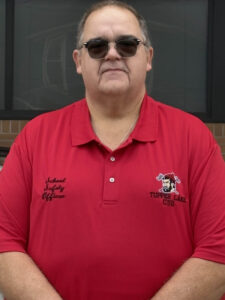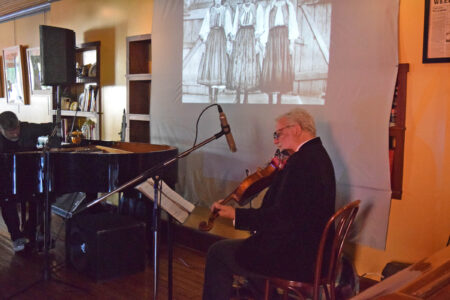Big jump in new Smitties
New PSC student enrollment up 30%, total enrollment around the sameMichael Rivera
- Paul Smith’s College students in their first year at the college listen to Professor Curt Stager give an introduction to the college’s geologic and cultural history on Monday. The college saw a 30% increase in new students at the start of classes this year. (Enterprise photo — Aaron Marbone)
- Paul Smith’s College students in their first year laugh as they collectively create the sound of a rainstorm at an introductory session to the campus on Monday. The college saw a 30% increase in new students at the start of classes this year. (Enterprise photo — Aaron Marbone)
- Paul Smith’s College students in their first year laugh as they collectively create the sound of a rainstorm at an introductory session to the campus on Monday. The college saw a 30% increase in new students at the start of classes this year. (Enterprise photo — Aaron Marbone)
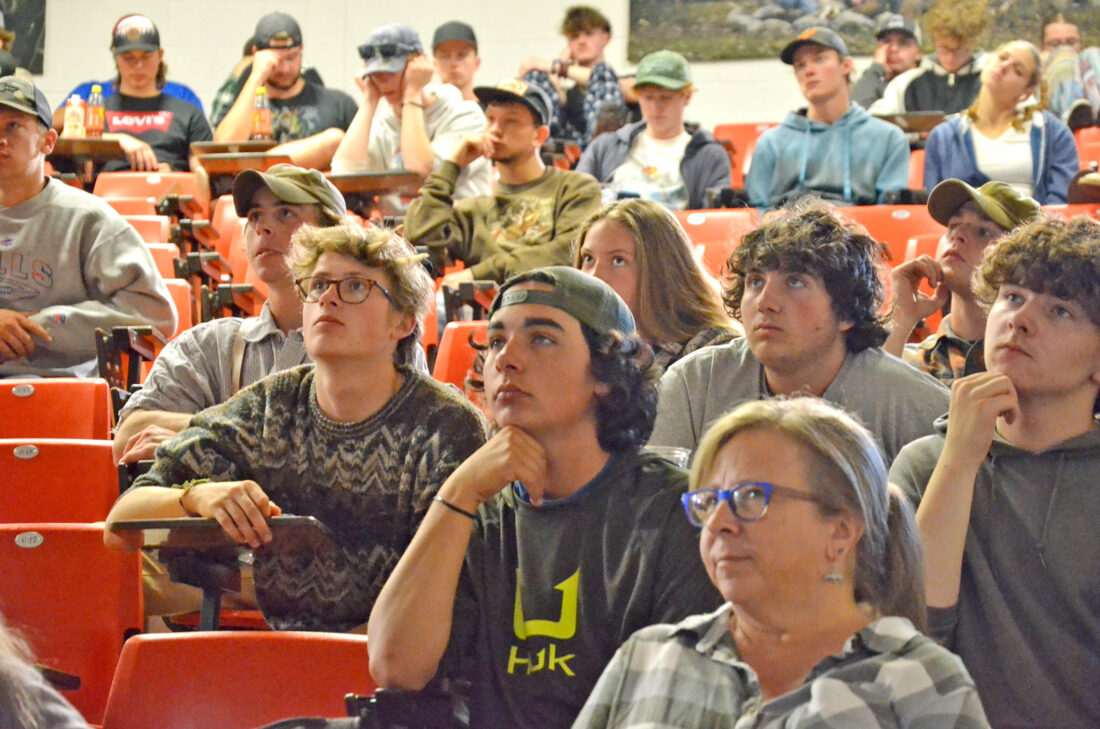
Paul Smith’s College students in their first year at the college listen to Professor Curt Stager give an introduction to the college’s geologic and cultural history on Monday. The college saw a 30% increase in new students at the start of classes this year. (Enterprise photo — Aaron Marbone)
PAUL SMITHS — Paul Smith’s College President Dan Kelting and Executive Vice President of Advancement and Enrollment Kathy Bonavist were “giddy” on Monday.
The numbers for their student census had just come in and they showed that the private college started its fall semester with a 30% increase in new students over last fall — its second-largest year-to-year new student increase since the 1980s.
Total enrollment is at 584 undergraduates, around what it was last year — due to an especially large graduating class of 181 in May. Still, the increase of new students coming to the college — from 176 last year to 227 this year — was huge news for Kelting and Bonavist, who have been working hard to turn PSC’s enrollment around after years of decline.
Bonavist has worked in advancement and enrollment for colleges around the country.
“For a college like us, 3%, 4% is a big win,” she said of PSC.
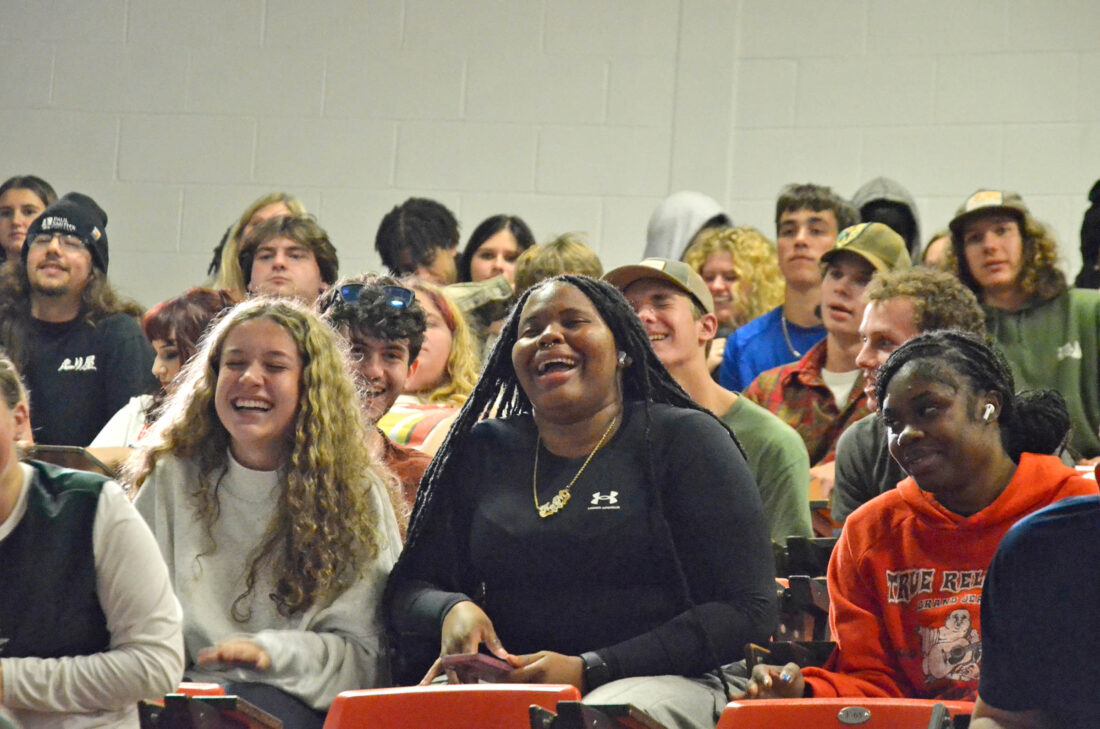
Paul Smith’s College students in their first year laugh as they collectively create the sound of a rainstorm at an introductory session to the campus on Monday. The college saw a 30% increase in new students at the start of classes this year. (Enterprise photo — Aaron Marbone)
What led to the large increase?
“Sheer grit,” according to Kelting.
He said the entire college community has been working to improve enrollment through an independent, do-it-yourself effort.
–
Rebuilding
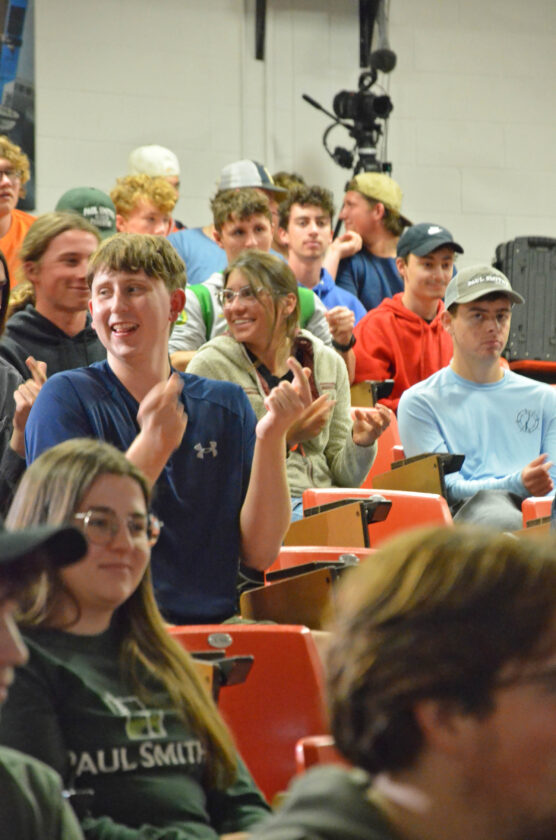
Paul Smith’s College students in their first year laugh as they collectively create the sound of a rainstorm at an introductory session to the campus on Monday. The college saw a 30% increase in new students at the start of classes this year. (Enterprise photo — Aaron Marbone)
–
The college has been going through ups and downs in recent years. Enrollment peaked in 2012 with 1,050 students. It has been on the decline ever since, bringing revenue down with it. The coronavirus pandemic brought the highest new student increase in the modern era in 2021, slightly above this year’s. But the college was shrinking. It had five presidents in two years. It attempted to be acquired by New York City-based educational nonprofit Fedcap, but staff quit in droves, citing a “toxic” work environment in the acquisition process. Their positions were not being filled. There was a rumor that the college was closing, which was a misinterpretation.
Last year, Kelting said they could not cut their way to success. He said the college started investing in people, and that investment is paying off.
Two years ago, the college did not have an enrollment department. It rebuilt the enrollment team under Bonavist.
For Bonavist, PSC has been a “passion project.” She worked there for many years in the 2000s and saw the highest modern enrollment for the college while she was there — over 1,000. After she left the college, she never left Saranac Lake, but she worked remotely for colleges around the country. She said it’s a “dream job” to take what she learned at all those institutions and apply it to a place she loves.
Kelting added that her return prompted other staff who had left to return, too. He said staff who left during tough times, feeling the college was not going in a direction they wanted during the failed Fedcap acquisition, returned when Bonavist returned because she had their trust.
The planned acquisition by Fedcap was pitched as a saving grace for the college but ultimately came with a period of “great instability” and low morale.
Kelting was concerned about the poor perspective of the institution from that era lasting, but said there is a better on-campus perception of PSC by students, faculty and staff than there was a few years ago. Kelting said staff had energy and excitement to preserve the institution themselves, without outside help.
“We’re like a startup,” Kelting said. “We’re very nimble. We don’t have a lot of bureaucracy.”
He said they can fail quickly and have the freedom to experiment and be creative. It’s actually fun for them, he said. Bonavist said she tries to empower employees to act on good ideas they have.
Kelting is grateful for the support of the college’s board of trustees.
–
Finances
–
Kelting said PSC’s finances are “solid.” As a private college, their budget is not made public, but he said it is balanced through the end of the year. He also said the college has a “healthy” endowment.
According to the college’s 990 form from the IRS, an annual, publicly available document with financial information on the college, the college spent $7.4 million more than it took in revenue last year. In 2024, PSC had $34.4 million in revenue, down from $39.5 million in 2023. Kelting said a structural deficit like this is common for colleges experiencing enrollment decline — as many have.
The college’s revenue has fluctuated up and down in recent years. It has not turned a profit since 2017. Before then, sometimes it would, sometimes it would not. The 2020 filing has the smallest deficit in recent years, -$595,000. Kelting said the preliminary numbers from the yet-to-be-finished 2025 form 990 show the college being close to “net zero” this year.
The revenue in 2024 is around the same dollar amount as in 2012. But expenses then were $34.6 million. In 2024, they were $41.8 million.
The college had a total long-term debt of $11.86 million in 2020. It has been paying that down and reported $8.5 million in long-term debt in 2024, according to the 990 form. The final payments for these loans are due in 2028. Kelting said the debt — which was taken out for dorm construction — is actually low debt for a college.
The tuition rate for full-time undergraduate students at Paul Smith’s College this year is set at $33,961. That is up from $32,972 last year and matches the college’s average 3% annual increase.
The College Board, a nonprofit organization, lists the national average tuition rate for private colleges at $43,350 for 2024-25. The U.S. News & World Report media company says the national average cost of tuition at private colleges is $43,505.
–
New offerings
–
Kelting and Bonavist feel confident that the growth will continue next year, since the growth in new students this year did not come from a one-time drastic change in the college’s offerings — rather, a change in how the college was marketed and budgeted.
“All of our growth has been coming from our regular programs,” Kelting said.
Kelting said they are reimagining some programs. The culinary and hospitality programs had some of the college’s highest enrollments for years. But enrollment has dwindled in these programs.
The culinary program had not been marketed for three years. That resumed last year. Bonavist said when they turned the proverbial “spigot” back on, students started signing up again.
The college recently created a new Institute for Adventure, Hospitality and Food in an effort to renovate its culinary program. Kelting said culinary programs usually teach broad skills, but shallow experience in each skill. The college is pivoting to teach more focused, “artisan” specialties — teaching it as a craft.
He said hotel chains like Marriott and Hilton are getting into the glamping industry and that PSC is positioned to offer education for that growing industry.
The Battlefish Academy one-semester small business certification program for veterans starts next week.
The college introduced a psychology major in 2018. Kelting said it’s always had high interest in prospective students, but a low yield in actual students enrolling. They are tweaking it to Paul Smiths College-ify it so it’s not cookie-cutter and plays into PSC’s uniqueness, offering an outdoor therapy bachelor’s degree.
PSC has 23 graduate students and is introducing a new graduate program in sustainable tourism.
–
Marketing
–
Bonavist said they’ve been focusing on “location, location, location” — doubling down on the niche aspects of the college.
“Our uniqueness is really our strength,” Kelting said.
Bonavist said they’re looking at things through a PSC “lens.”
They spent six months speaking to students, faculty, staff and alumni about how to market the college. They worked with an ad agency to develop a new website and worked with photographers to develop new visuals. They tested these new materials with alumni and prospective students.
The college gets survey data from the SAT and ACT, which is used to target potential students with mailers. Bonavist said they sent out 100,000 mailers last fall and will send 130,000 mailers this year.
She also said the college is starting to partner with a Silicon Valley startup testing an artificial intelligence college consultant. Wealthy students can afford consultants to help them with writing their college essays, she said. This service helps college applicants get prompts for writing their college essays and then shares their info with colleges. If someone’s essay mentions birdwatching, enjoying winter or hiking — if it implies they might like a college emphasizing the outdoors — Paul Smith’s will be able to target them with promotion.
One key part of the marketing has been to encourage prospective students to see themselves becoming Adirondackers. Becoming a Smitty is becoming an Adirondacker, they said. Last May, Kelting personally counted 400 kayaks on campus.
Bonavist said PSC alumni have “stickiness.” In the Tri-Lakes, she said, one in 30 people is a Smitty. Of the college’s 11,000 living alumni, nearly one in six live in the Adirondack Park.
The college is a major employer and economic driver in this area. Its students live in the community, its staff research the Adirondack climate and its alumni work at or own businesses all over the region.
Kelting said they had a hint the number of new students at PSC would be high this year. At convocation, the line of students stretched from the Joan Weill Adirondack Library to Freer Hall.




